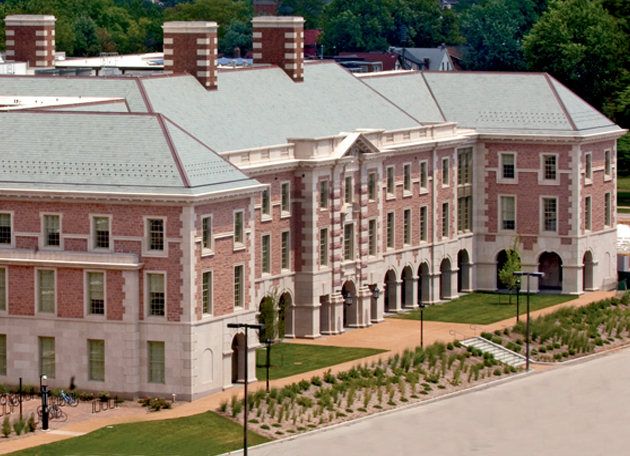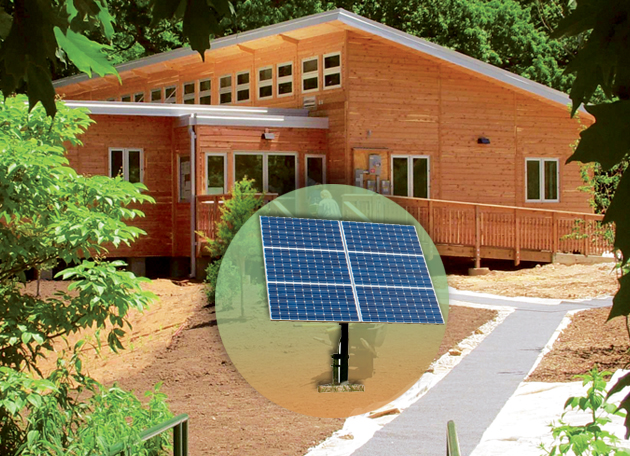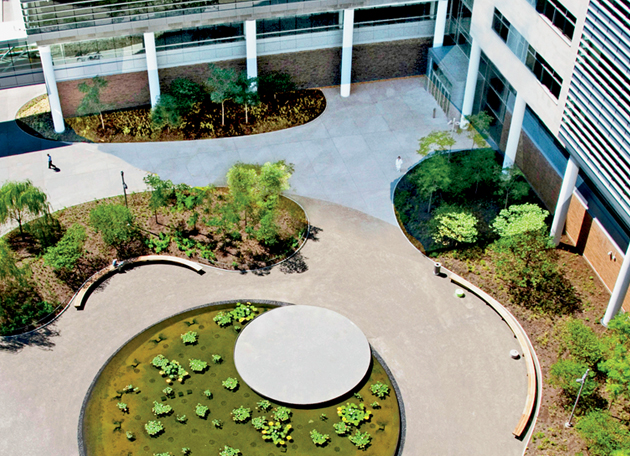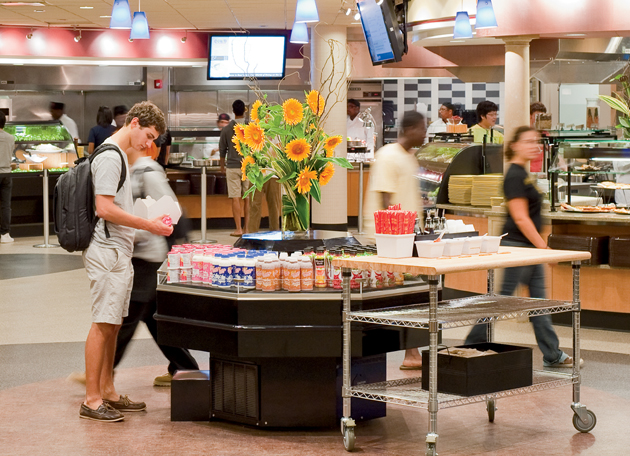
When Dean Ralph S. Quatrano, PhD, welcomes visitors to the new Stephen F. and Camilla T. Brauer Hall at the School of Engineering & Applied Science, the first stop he makes with them is at the energy smartboard in the atrium.
Here, at the touch of a fingertip, the curious can see exactly what utilities the building is using at any moment. (For that matter, the curious can access the same information from any Internet-connected computer at http://engineering.wustl.edu/brauerdashboard.) The smartboard shows real-time electricity, water and natural gas consumption, and solar and wind energy generation. It also explains Brauer Hall’s many green features.
The smartboard exemplifies the cutting-edge green technology that shapes Brauer Hall. It exemplifies as well Washington University’s ever-deepening commitment to environmental sustainability, to using every available technique to make its campuses as Earth-friendly as possible.
The quest for sustainability plays out in many ways at the university — in local foods served in the dining halls, in an emphasis on car-sharing and public transportation, in comprehensive recycling — but perhaps nowhere as dramatically as in the growing list of new and restored green buildings that have won LEED certification from the U.S. Green Building Council (USGBC). LEED stands for Leadership in Energy and Environmental Design; certification at the basic, silver, gold or platinum level means a building has met the requisite number of USGBC’s LEED criteria, which govern everything from energy use to native plantings to recycling to water conservation, even parking spaces for hybrid cars.
Twelve university buildings have achieved LEED certification, and another three are under construction or in the certification process (at press time, the Family Learning Center earned a LEED Gold rating, raising the total number to 13, with one building awaiting certification and another under construction). The university is committed to achieving a minimum LEED Silver designation in all new and restored buildings, higher levels where possible.
“Washington University’s commitment to buildings that have minimal effects on the environment is a part of our overall effort to promote environmental sustainability,” Chancellor Wrighton says.
“Washington University’s commitment to buildings that have minimal effects on the environment is a part of our overall effort to promote environmental sustainability,” Chancellor Mark S. Wrighton says. “We know facilities built today will benefit future generations of Washington University students and faculty, and LEED-certified buildings reflect our responsibility to ensure a brighter future.”
Reaching even beyond LEED, the Living Learning Center at Tyson Research Center became one of the first two buildings worldwide to win the Cascadia Region Building Council’s global Living Building Challenge last fall. The Living Learning Center presents advanced systems, solar panels, composting toilets and other sophisticated features, and it manufactures zero net impact on the environment, both from construction and in its ongoing operation. It takes no net power from the grid; it collects water for all its needs; its materials are all local.
Green Building Equals Savings
What makes a building green? Features will vary across buildings, but at Brauer Hall the primary focus is on energy conservation. Leading-edge systems save power. Sensors detect occupants within rooms and regulate heating and cooling levels accordingly. A highly reflective roof membrane reflects the sun’s heat to reduce air conditioning use. Solar panels and a wind turbine on the roof generate a small amount of power but also support research into renewable energy.
Important as energy issues are, Brauer Hall also incorporates many other sustainability features. Native plants adorn the grounds and are watered by collected stormwater runoff. Low-flow bathroom fixtures also save water. Shredded blue jeans insulate the walls.
Brauer’s Distance Learning Center is another potent energy saver. Sophisticated presentation technologies in this 80-seat classroom — the first of its kind on campus — can link students and faculty there to academic presentations far from St. Louis. Describing one such event, Quatrano notes: “About 70 Washington University students and faculty recently participated in a seminar hosted at the University of Missouri. They were able to observe the speaker and see the audience; in fact, both sides were able to see and interact with one another — and no one had to drive to Columbia. This was safer and greener.”
Brauer Hall’s exceptional design won it the coveted LEED Gold designation.
Brauer, Tyson’s Living Learning Center and the other green buildings bear convincing witness to the university’s commitment to sustainability, to reducing its carbon footprint.
Two daunting challenges confront this commitment, however. The first rises from the university’s St. Louis location, where conventional electricity is relatively inexpensive. “The climate creates considerable limits on renewables,” says Henry Webber, executive vice chancellor for administration. “We are a relatively poor region for wind and a mediocre region for solar. Combined with low electrical rates, this makes renewables economically inefficient. And we face the problem of hot, humid summers and relatively cold winters.”
The university’s dramatic growth over the past 20 years has produced the second challenge. The square footage encompassed in its buildings has almost doubled since 1990. Both in construction and in ongoing operations, buildings consume energy and water and produce emissions and waste products.
“We’ve grown rapidly,” Webber notes, “because we’re meeting our mission of teaching, research and patient care. We’ve added students; we’ve added faculty; we’ve added facilities.”
In light of this growth, it is notable that the university’s greenhouse gas emissions have grown by considerably less, just 27 percent.
But efforts to further reduce energy consumption are “crucial,” according to the university’s Strategic Plan for Environmentally Sustainable Operations. A commitment to constructing only LEED-certified buildings is key to these efforts.
“We have a responsibility as a leading national university to model a certain kind of behavior,” Executive Vice Chancellor Webber says. “We have a responsibility to our students and to the region.”
To explore Washington University’s green buildings is to discover a host of innovative techniques. The new BJC Institute of Health at the School of Medicine offers many examples. In energy savings, sensors “harvest” daylight, measuring light levels and reducing artificial lighting as appropriate; abundant windows multiply this effect. Motion sensors detect occupancy and raise and lower heating and cooling settings. Efficient fume hoods close when not in use to retain heat. Lab refrigerators are EnergyStar rated for high efficiency. Even heat generated by water chilling systems is recaptured and used elsewhere. “In the past,” says Steve Sobo, director of design and development at the medical school, “that heat would just get vented out of a building. Now we’re reusing it.” Energy use alone is expected to be nearly 20 percent lower than in a building without these features.
Another important green feature concerns materials. “We tried to make sure that all materials, furniture and equipment were either obtained or manufactured within a 500-mile radius of the project,” Sobo explains, thus minimizing emissions from transportation. Among the innovative materials: Missouri blue limestone for the lobby’s flooring.
Outside the building lies a beautiful plaza, designed with the help of the Missouri Botanical Garden (MBG). “We used only native vegetation,” Sobo notes. “We went out to the [MBG’s] Shaw Nature Reserve and tried to mirror the ground cover and trees there. The plaza features 40,000 bedding plants and 85 trees,” including oaks, redbuds, willows and Kentucky coffee trees. Using native plants reduces the need for fertilizer, pesticides and irrigation. What watering is needed comes through soakers beneath the mulch, Sobo says, and that system will shut down after the first year when the plants are established.
Even pre-construction demolition had a green edge — fully 97 percent of the demolition waste from an old garage was recycled. “The concrete is reused,” Sobo explains. “The rebar is separated out and goes to a metal recycler. Wood, of course, gets turned into pulp, which gets turned into paper. There’s a method for recycling drywall. And,” he adds, “a lot of things like glass and electric cables end up in asphalt.”
The 680,000-square-foot building awaits certification at the LEED Gold level.
Because green building produces substantial savings — in energy and water, in maintenance for landscaping, in waste disposal — it produces cost savings for the university. Though the initial investment is typically higher, a good green building over its life cycle will more than pay back that investment. “We construct buildings with the assumption that they are very long-term investments,” Webber says. “Many of the elements that make a building green are things that make it efficient over the long run. I think of green as both environmentally and economically sustainable.”

Something old, someting new
This sustainability applies not only to new structures but also to the venerable Cope and Stewardson buildings, the historic heart of the Danforth Campus. Dating to the early years of the 20th century, these Collegiate Gothic buildings have an august presence and a craftsmanship that is hard to duplicate today.
Additionally, they turn out to be eminently amenable to green retrofits. “Our old buildings, with very thick masonry walls, are a good base for green rehabbing,” Webber notes. “They are comparatively narrow, built for good ventilation, with a lot of natural light that penetrates from either side.”
The university is restoring buildings to pristine condition for the next 100 years — at perhaps 60 percent of the cost of a new building — by using the existing shells and cores. These retrofits focus on cutting-edge heating, ventilation and air conditioning systems; efficient lighting; low-flow plumbing; recycling demolition and construction debris; and using materials manufactured within 500 miles of campus.
“We can do a terrific upgrade; we can restore them; and we can make them much more energy efficient. And,” Webber adds, “the Cope and Stewardson buildings are beautiful. They are a defining part of our culture.” (Green restoration is complete in Busch and Wilson halls and under way in Cupples II.)

Doing the right thing
Fundamentally, the university has adopted a green building strategy because it is the right thing to do. “As citizens of the planet,” Quatrano asserts, “it is important to contribute to the planet’s sustainability. Much of the negative carbon footprint is due to buildings. We recognize that as part of our responsibility.”
Webber agrees. “We have a responsibility as a leading national university to model a certain kind of behavior,” he says. “We have a responsibility to our students and to the region.”
By doing the right thing, Webber says, the efforts also support the university’s mission of being careful stewards of resources. “We spend about $24 million a year on energy,” he says. “If we could reduce that by 10 percent over the next five years, that’s $2.4 million more annually we could spend on teaching, research and patient care.”
Enhancing buildings, enhancing health
Larry J. Shapiro, MD, executive vice chancellor for medical affairs and medical school dean, puts it in terms of health. “Our mission at the School of Medicine is to make society healthier,” says Shapiro, the Spencer T. and Ann W. Olin Distinguished Professor. “We believe sustainable buildings enhance the health of people by protecting our planet.”
Beyond the ethical imperatives and the savings, green building produces substantial additional benefits for faculty, students and staff: Educationally, these buildings have significant teaching power.
“Being in this building,” Quatrano says of Brauer Hall, “sustainability is all around us. Experiencing all the ways it is green reveals to students that they should be thinking about sustainability issues.”
That awareness leads to a kind of infectious enthusiasm for Earth-friendly measures. Recently a staff member proudly displayed a new mouse pad. “Turns out the bottom is made from recycled tires,” Quatrano says. “And I thought, of course, we in engineering are going to have mouse pads made from recycled tires!”
Green building could also encourage new research, sparking student interest in new topics. “I think students are going to be imagining ways in which engineering could lead to more green materials, more efficient machines, more efficient construction practices, and thinking: ‘Maybe this would be a research topic I’d like to explore,’” Quatrano says.
Beyond education and research value, though, Washington University’s green building strategy has simply created beautiful spaces in which to work and study. “These are buildings that are good for the planet but also good for the people in them,” Webber says. “We have shown that we can build buildings that are very attractive, very functional, and very good for the planet — all at the same time.”
Betsy Rogers is a freelance writer based in Belleville, Ill.

Comments and respectful dialogue are encouraged, but content will be moderated. Please, no personal attacks, obscenity or profanity, selling of commercial products, or endorsements of political candidates or positions. We reserve the right to remove any inappropriate comments. We also cannot address individual medical concerns or provide medical advice in this forum.